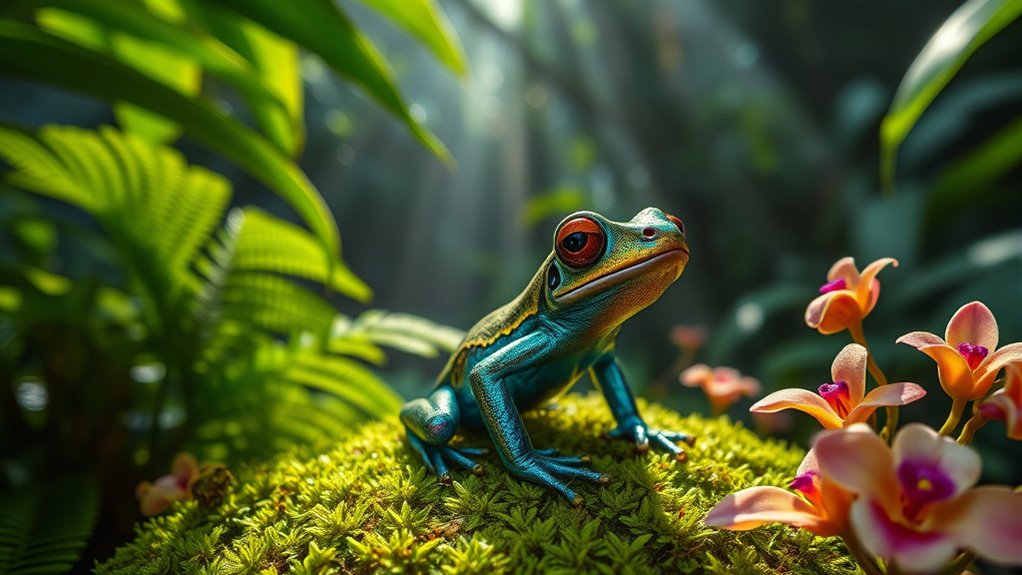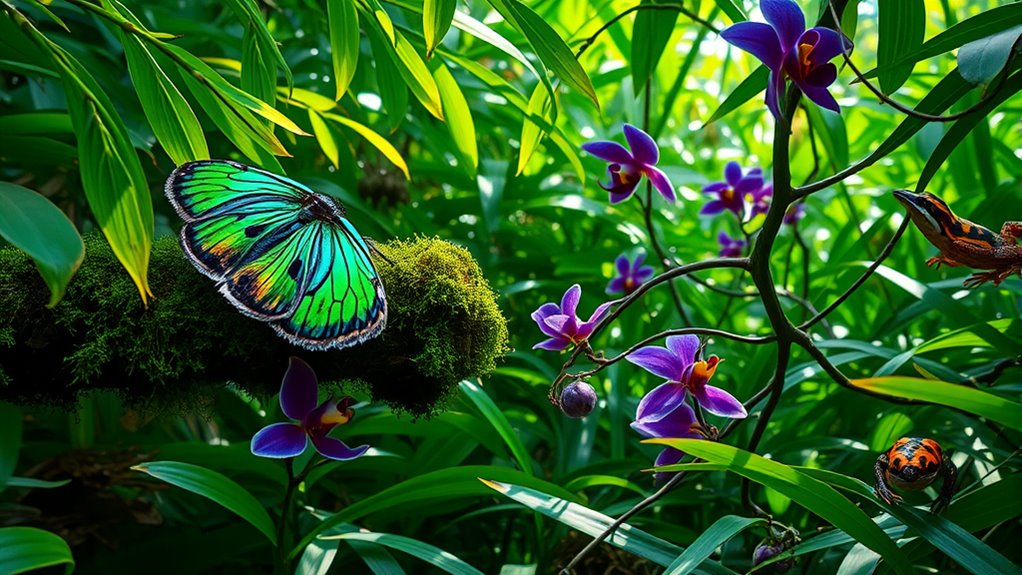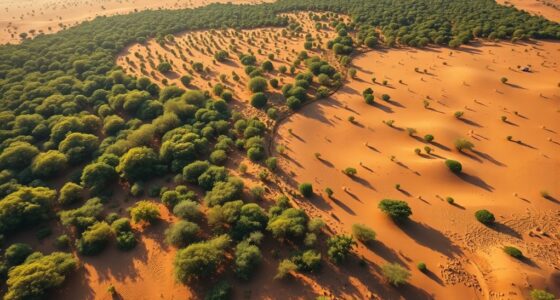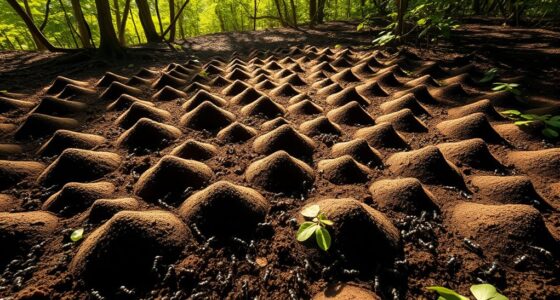Recent discoveries in the remote Amazon rainforest reveal an incredible array of newly identified species, highlighting the region’s unmatched biodiversity. These findings remind you of the rainforest’s richness and the importance of ongoing scientific exploration. However, the Amazon faces threats like deforestation and illegal mining, risking many unknown species. Protecting this crucial ecosystem requires understanding its complexity. Keep exploring to learn more about how conservation efforts can help preserve this living library for future generations.
Key Takeaways
- Recent expeditions have uncovered several new species, highlighting the Amazon rainforest’s exceptional biodiversity.
- Discoveries emphasize the importance of ongoing scientific exploration to understand and protect the region’s ecosystems.
- New species findings showcase the Amazon as a vital “living library” of unique flora and fauna.
- These discoveries underscore the urgency of conservation efforts amid threats like deforestation and illegal mining.
- Integrating indigenous knowledge enhances conservation strategies to preserve biodiversity and cultural heritage.

Scientists have recently uncovered several new species deep within the Amazon Rainforest, highlighting the region’s incredible biodiversity. This discovery underscores both the richness of this ecosystem and the urgent need to address conservation challenges that threaten its survival. As you explore these findings, it becomes clear that understanding the complexities of the rainforest requires more than just scientific exploration; it also depends on integrating indigenous knowledge, which has preserved this environment for generations.
New Amazon discoveries reveal incredible biodiversity and the importance of integrating indigenous knowledge for conservation.
The Amazon’s vastness and complexity pose significant conservation challenges. Deforestation, illegal mining, and climate change continue to erode habitats at an alarming rate. You might not realize that these threats aren’t just environmental—they also threaten the cultural heritage of indigenous communities who have lived in harmony with the rainforest for centuries. Their traditional knowledge offers essential insights into the delicate balance of the ecosystem. It’s through their eyes that you can better understand how to protect these newly discovered species and the larger environment they inhabit. Indigenous communities often possess detailed knowledge about local flora and fauna, behaviors, and ecological relationships that scientists are just beginning to understand. Respecting and incorporating this knowledge into conservation efforts could be key to creating sustainable strategies that benefit both biodiversity and the people who rely on these ecosystems. Recognizing the importance of indigenous knowledge can enhance conservation outcomes significantly.
You should recognize that the discovery of new species isn’t just an academic achievement; it’s a stark reminder of what’s at stake. Many species still remain unknown, and without proper conservation, they could disappear before we even learn about them. The challenge lies in balancing development with preservation. Governments, NGOs, and local communities need to work together to establish protected areas, enforce anti-poaching laws, and promote sustainable land use. Your role as someone concerned about biodiversity involves supporting these initiatives and advocating for policies that prioritize ecological health over short-term gains.
Furthermore, fostering collaboration with indigenous peoples can strengthen conservation efforts. Their traditional practices often align with sustainable management, providing models for how to coexist with nature. By respecting their rights and knowledge, you not only honor their cultural heritage but also enhance the effectiveness of conservation initiatives. The discovery of new species in the Amazon underscores the importance of viewing the rainforest as a living library—one that requires careful stewardship. Additionally, employing innovative conservation technologies can help monitor environmental changes and combat illegal activities threatening these ecosystems. Protecting these hidden gems demands an integrated approach that values scientific research, safeguards indigenous rights, and confronts the ongoing conservation challenges head-on. Only through such collective action can we ensure that the Amazon’s incredible biodiversity continues to thrive for generations to come.
Frequently Asked Questions
How Do Scientists Determine a New Species?
When you ask how scientists determine a new species, they start with detailed morphological comparisons to identify physical differences. They also use DNA analysis to examine genetic distinctions. If both methods show significant variation from known species, scientists can confidently classify it as new. This process guarantees accurate identification, helping us understand biodiversity. You can think of it as combining visual clues with genetic evidence to uncover unique species.
What Is the Ecological Role of These New Species?
You might think these new species are just tiny additions, but they actually hold the key to ecological balance! Their ecological significance is enormous, impacting everything from food chains to biodiversity conservation efforts. By understanding their roles, you help protect essential ecosystems. These discoveries remind you that every species, no matter how small, can be a cornerstone for maintaining the health and resilience of our planet’s precious biodiversity.
Are There Any Threats to These Newly Discovered Species?
You should know that these newly discovered species face threats from habitat destruction and invasive species. Deforestation and land conversion reduce their living spaces, making survival harder. Additionally, invasive species can outcompete or prey on them, disrupting their ecosystems. If you want to protect these species, efforts to preserve their habitats and control invasive species are vital. Without action, their populations could decline or disappear entirely.
How Long Does It Take to Classify a New Species?
When you ask how long it takes to classify a new species, it varies based on complexity. Typically, scientists start with field observation to identify unique traits. Then, they perform genetic analysis to confirm its distinctiveness. This process can take months or even years, depending on the species and available data. Accurate classification requires careful study, ensuring the species is truly new before officially naming and cataloging it.
Can Local Communities Access or Benefit From These Discoveries?
Imagine stumbling upon a hidden treasure—local communities can benefit from new species discoveries through community participation and indigenous knowledge. When locals are involved, they gain access to resources, training, and recognition, empowering them economically and culturally. This collaboration fosters sustainable practices and ensures they share in conservation rewards. Your engagement makes a difference, turning scientific breakthroughs into true community benefits, preserving both biodiversity and local livelihoods for generations to come.
Conclusion
As you read about this new species, remember that each discovery is a reminder of nature’s hidden treasures waiting to be uncovered. The Amazon’s depths hold secrets more precious than gold, shining a light on the incredible diversity that sustains our planet. By protecting these forests, you become a guardian of this fragile paradise, ensuring that future generations can still marvel at life’s endless wonder. After all, isn’t it our shared responsibility to preserve this vibrant tapestry?









